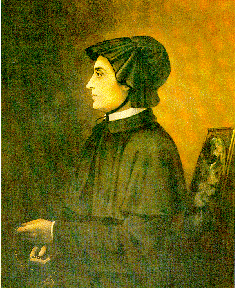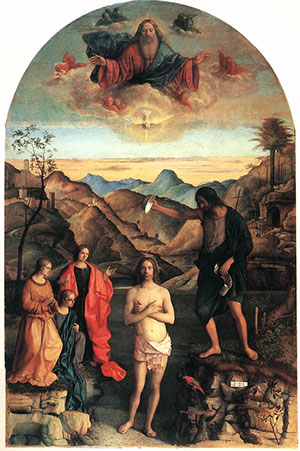Feast day: Jan. 4
 St. Elizabeth Ann Seton was the foundress and first superior of the Sisters of Charity in the United States, and the foundress of the first Catholic girls’ school in the nation. She was also the first person born in what would become the United States to be canonized by the Catholic Church.
St. Elizabeth Ann Seton was the foundress and first superior of the Sisters of Charity in the United States, and the foundress of the first Catholic girls’ school in the nation. She was also the first person born in what would become the United States to be canonized by the Catholic Church.
She was born to Episcopalian parents into New York City high society on Aug. 28, 1774.
Her father, Dr. Richard Bayley, was the first professor of anatomy at Columbia College and praised for his work as the health officer of the Port of New York. Her mother, Catherine Charlton, daughter of an Anglican minister of Staten Island, N.Y., died when Elizabeth was 3 years old, leaving her and two other young daughters.
Elizabeth was married on Jan. 25, 1794, in St. Paul’s Episcopalian Church to William Magee Seton. When his father died, they took over custody of William’s seven half-brothers and half-sisters, as well as the family’s importing business. William fell into financial troubles, and later died of tuberculosis in Pisa, Italy, in December 1803 while attempting to get help from his business friends. After getting to know the Catholic Church in Italy, Elizabeth fasted and prayed for light. Finally, on Ash Wednesday, March 14, 1805, she was received into the Church.
Her conversion unleashed a storm among her Protestant relatives and friends and made her financial strains even greater. In January 1806, Cecilia Seton, Elizabeth’s young sister-in-law, became very ill and begged to see the ostracized convert and told her of her desire to become a Catholic. When Cecilia’s decision was known, threats were made to have Mrs. Seton expelled from the state by the Legislature. On her recovery, Cecilia fled to Elizabeth for refuge and was received into the Church.
Elizabeth moved to Baltimore in 1808 and with the help of a Catholic convert, a farm was purchased two miles from Mount St. Mary’s College and Mrs. Seton took vows privately before Archbishop Carroll and her daughter Anna.
In 1810, Bishop Flaget was commissioned to obtain in France the rules of the Sisters of Charity of St. Vincent de Paul. The rule, with some modifications, was approved by Archbishop Carroll in January 1812, and adopted. Mrs. Seton was elected superior against her will and in spite of the fact that she had also to care for her children. Many joined the community; including Mother Seton’s daughter, Anna, who died during her novitiate (March 12, 1812), but had been permitted to pronounce her vows on her deathbed. Mother Seton and 18 sisters made their vows on July 19, 1813.
The third time she was elected superior in 1819, she protested that it was the “election of the dead,” but she lived for two years more, finally succumbing to a pulmonary infection. She died in Emmitsburg, Md., on Jan. 4, 1821.
In 1880 Cardinal Gibbons (then Archbishop) urged the steps be taken toward her canonization. Elizabeth Ann Seton was beatified in 1963, and she was canonized on Sept. 14, 1975.
She is the patroness of Catholic schools and widows, as well as the State of Maryland.
— Catholic News Agency
 “The Baptism of Christ” by Giovanni Bellini. On display at Santa Corona, Vicenza, Italy.On the second Sunday of January, the Church celebrates the Feast of the Baptism of the Lord, and it is with this awe-filled liturgy that the three great revelations or “theophanies” of the Christmas season are brought to stunning fulfillment.
“The Baptism of Christ” by Giovanni Bellini. On display at Santa Corona, Vicenza, Italy.On the second Sunday of January, the Church celebrates the Feast of the Baptism of the Lord, and it is with this awe-filled liturgy that the three great revelations or “theophanies” of the Christmas season are brought to stunning fulfillment.
The first of these revelations was the birth of the Christ child, which was celebrated on Christmas Day. This “theophany” presented to us the first occasion when it was made known to human sight that God had accepted for Himself a human nature and allowed Himself to be born in this world as a man. God comes to Israel and the world in much the same manner as we all have. God is born in Christ to particular parents, into a particular family, and at a particular place and time. God is who Christ is – as an infant, as a child and as a grown man: Christ is God!
The second of these revelations was commemorated in the United States on the solemnity of Christ’s Epiphany. In this liturgy, the theophany of Christ as Messiah (that is, as the true King of Israel) was revealed. With this revelation came also signs that foreshadowed Christ’s mission – a mission by which He would transform both Israel and the world. The Church professes and believes that Christ is the fulfillment of the expectations of Israel that God would send to His people a Messiah; but more than this, we believe that it is the God of Israel Himself who comes into this world as the Messiah!
The third of these revelations is presented in the liturgy in which the Church accepts and discerns the event of Christ’s Baptism.
Though this event hearkens to and foreshadows the Church’s Sacrament of Baptism, we shouldn’t confuse the two. Christ does not receive the Sacrament of Baptism, and what John imparts is not what the Church is doing when people are baptized.
The baptism of John was a ritual act of purification which was much like the mikvah that a faithful Israelite accepted before they entered the precincts of the Temple. John presented his mikvah or baptism as an act by which one would be prepared to receive the Messiah and enter with Him into the Messianic Age.
It is mysterious as to why Christ would Himself accept this kind of baptism.
Perhaps it is to show the depth of His identification with Israel and that, as their Messiah, He would not expect or ask anything of His chosen people that He would not at first undergo Himself.
Or maybe it is to foreshadow His immersion into sin and death in the terrifying event of the cross. As He descends into the depths of the Jordan River and then emerges, so will it be in His Paschal Mystery.
The Fathers of the Church presented the insight that as Christ immersed Himself in the waters of John’s baptism, He sanctified all the waters of the world for use in the Church’s Sacrament of Baptism.
These are all interesting and helpful insights, but none in itself is the revelation or the theophany that this feast’s liturgy presents.
The great revelation of the Lord’s Baptism is discerned, not in the reason that He accepts Baptism, but that in that moment something about God’s identity was revealed that was not fully known or even believed to be possible. The Baptism of Christ is the occasion when the Trinity is revealed – the Son makes Himself known, the Father speaks and the Holy Spirit descends. It is this mystery, the mystery of the Trinity, that brings the revelations or the theophanies of the holy season of Christmas to their fulfillment.
The lesson?
Remember Christians, you do not believe that God is merely an idea in your mind or a projection of your best self. God is not for you some unknown and unknowable force in the universe or a feeling that you contain in your heart. The one, true God has revealed Himself in Christ as the Trinity – the mysterious communion of Father, Son and Holy Spirit, a communion of Divine Love “in which we live and move and have our being.” It is this Divine Love that brought all into existence, and because of Christ, it is to this Divine Love that we will all one day return.
— Father Steve Grunow Word of Fire.Father Steve Grunow is the CEO of Word on Fire Catholic Ministries.

